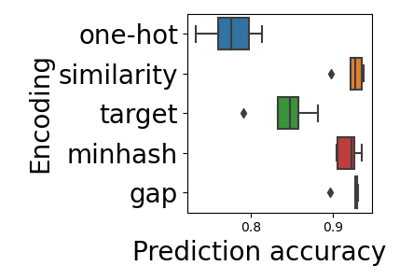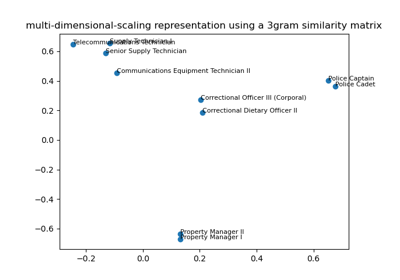dirty_cat.GapEncoder¶
Usage examples at the bottom of this page.
- class dirty_cat.GapEncoder(n_components=10, batch_size=128, gamma_shape_prior=1.1, gamma_scale_prior=1.0, rho=0.95, rescale_rho=False, hashing=False, hashing_n_features=4096, init='k-means++', tol=0.0001, min_iter=2, max_iter=5, ngram_range=(2, 4), analyzer='char', add_words=False, random_state=None, rescale_W=True, max_iter_e_step=20, handle_missing='zero_impute')[source]¶
Constructs latent topics with continuous encoding.
This encoder can be understood as a continuous encoding on a set of latent categories estimated from the data. The latent categories are built by capturing combinations of substrings that frequently co-occur.
The
GapEncodersupports online learning on batches of data for scalability through thepartial_fit()method.The principle is as follows:
Given an input string array X, we build its bag-of-n-grams representation V (n_samples, vocab_size).
Instead of using the n-grams counts as encodings, we look for low- dimensional representations by modeling n-grams counts as linear combinations of topics
V = HW, with W (n_topics, vocab_size) the topics and H (n_samples, n_topics) the associated activations.Assuming that n-grams counts follow a Poisson law, we fit H and W to maximize the likelihood of the data, with a Gamma prior for the activations H to induce sparsity.
In practice, this is equivalent to a non-negative matrix factorization with the Kullback-Leibler divergence as loss, and a Gamma prior on H. We thus optimize H and W with the multiplicative update method.
- Parameters:
- n_componentsint, optional, default=10
Number of latent categories used to model string data.
- batch_sizeint, optional, default=128
Number of samples per batch.
- gamma_shape_priorfloat, optional, default=1.1
Shape parameter for the Gamma prior distribution.
- gamma_scale_priorfloat, optional, default=1.0
Scale parameter for the Gamma prior distribution.
- rhofloat, optional, default=0.95
Weight parameter for the update of the W matrix.
- rescale_rhobool, optional, default=False
If True, use
rho ** (batch_size / len(X))instead of rho to obtain an update rate per iteration that is independent of the batch size.- hashingbool, optional, default=False
If True,
HashingVectorizeris used instead ofCountVectorizer. It has the advantage of being very low memory, scalable to large datasets as there is no need to store a vocabulary dictionary in memory.- hashing_n_featuresint, default=2**12
Number of features for the
HashingVectorizer. Only relevant if hashing=True.- init{‘k-means++’, ‘random’, ‘k-means’}, default=’k-means++’
Initialization method of the W matrix. If init=’k-means++’, we use the init method of
KMeans. If init=’random’, topics are initialized with a Gamma distribution. If init=’k-means’, topics are initialized with aKMeanson the n-grams counts.- tolfloat, default=1e-4
Tolerance for the convergence of the matrix W.
- min_iterint, default=2
Minimum number of iterations on the input data.
- max_iterint, default=5
Maximum number of iterations on the input data.
- ngram_rangeint 2-tuple, default=(2, 4)
- The lower and upper boundaries of the range of n-values for different
n-grams used in the string similarity. All values of n such that
min_n <= n <= max_nwill be used.
- analyzer{‘word’, ‘char’, ‘char_wb’}, default=’char’
Analyzer parameter for the
HashingVectorizer/CountVectorizer. Describes whether the matrix V to factorize should be made of word counts or character-level n-gram counts. Option ‘char_wb’ creates character n-grams only from text inside word boundaries; n-grams at the edges of words are padded with space.- add_wordsbool, default=False
If True, add the words counts to the bag-of-n-grams representation of the input data.
- random_stateint or
RandomState, optional Random number generator seed for reproducible output across multiple function calls.
- rescale_Wbool, default=True
If True, the weight matrix W is rescaled at each iteration to have a l1 norm equal to 1 for each row.
- max_iter_e_stepint, default=20
Maximum number of iterations to adjust the activations h at each step.
- handle_missing{‘error’, ‘empty_impute’}, default=’empty_impute’
Whether to raise an error or impute with empty string (‘’) if missing values (NaN) are present during
fit()(default is to impute). Ininverse_transform(), the missing categories will be denoted as None.
See also
dirty_cat.MinHashEncoderEncode string columns as a numeric array with the minhash method.
dirty_cat.SimilarityEncoderEncode string columns as a numeric array with n-gram string similarity.
dirty_cat.deduplicateDeduplicate data by hierarchically clustering similar strings.
References
For a detailed description of the method, see Encoding high-cardinality string categorical variables by Cerda, Varoquaux (2019).
Examples
>>> enc = GapEncoder(n_components=2)
Let’s encode the following non-normalized data:
>>> X = [['paris, FR'], ['Paris'], ['London, UK'], ['Paris, France'], ['london'], ['London, England'], ['London'], ['Pqris']]
>>> enc.fit(X) GapEncoder(n_components=2)
The
GapEncoderhas found the following two topics:>>> enc.get_feature_names_out() ['england, london, uk', 'france, paris, pqris']
It got it right, reccuring topics are “London” and “England” on the one side and “Paris” and “France” on the other.
As this is a continuous encoding, we can look at the level of activation of each topic for each category:
>>> enc.transform(X) array([[ 0.05202843, 10.54797156], [ 0.05000118, 4.54999882], [12.04734788, 0.05265212], [ 0.05263068, 16.54736932], [ 6.04999624, 0.05000376], [19.546716 , 0.053284 ], [ 6.04999623, 0.05000376], [ 0.05002016, 4.54997983]])
The higher the value, the bigger the correspondance with the topic.
- Attributes:
- rho_float
Effective update rate for the W matrix.
- fitted_models_list of
GapEncoderColumn Column-wise fitted GapEncoders.
- column_names_list of str
Column names of the data the Gap was fitted on.
Methods
fit(X[, y])Fit the instance on X.
fit_transform(X[, y])Fit to data, then transform it.
get_feature_names([col_names, n_labels, ...])Return clean feature names.
get_feature_names_out([col_names, n_labels, ...])Return the labels that best summarize the learned components/topics.
get_params([deep])Get parameters for this estimator.
partial_fit(X[, y])Partial fit this instance on X.
score(X)Score this instance on X.
set_output(*[, transform])Set output container.
set_params(**params)Set the parameters of this estimator.
transform(X)Return the encoded vectors (activations) H of input strings in X.
- fit(X, y=None)[source]¶
Fit the instance on X.
- Parameters:
- Xarray-like, shape (n_samples, n_features)
The string data to fit the model on.
- yNone
Unused, only here for compatibility.
- Returns:
GapEncoderThe fitted
GapEncoderinstance (self).
- fit_transform(X, y=None, **fit_params)[source]¶
Fit to data, then transform it.
Fits transformer to X and y with optional parameters fit_params and returns a transformed version of X.
- Parameters:
- Xarray-like of shape (n_samples, n_features)
Input samples.
- yarray-like of shape (n_samples,) or (n_samples, n_outputs), default=None
Target values (None for unsupervised transformations).
- **fit_paramsdict
Additional fit parameters.
- Returns:
- X_newndarray array of shape (n_samples, n_features_new)
Transformed array.
- get_feature_names(col_names=None, n_labels=3, input_features=None)[source]¶
Return clean feature names. Compatibility method for sklearn < 1.0.
Use
get_feature_names_out()instead.For each topic, labels with the highest activations are selected.
- Parameters:
- col_names‘auto’ or list of str, optional
The column names to be added as prefixes before the labels. If col_names=None, no prefixes are used. If col_names=’auto’, column names are automatically defined:
if the input data was a
DataFrame, its column names are used,otherwise, ‘col1’, …, ‘colN’ are used as prefixes.
Prefixes can be manually set by passing a list for col_names.
- n_labelsint, default=3
The number of labels used to describe each topic.
- input_featuresNone
Unused, only here for compatibility.
- Returns:
- list of str
The labels that best describe each topic. Each element contains the labels joined by a comma.
- get_feature_names_out(col_names=None, n_labels=3, input_features=None)[source]¶
Return the labels that best summarize the learned components/topics.
For each topic, labels with the highest activations are selected.
- Parameters:
- col_names‘auto’ or list of str, optional
The column names to be added as prefixes before the labels. If col_names=None, no prefixes are used. If col_names=’auto’, column names are automatically defined:
if the input data was a
DataFrame, its column names are used,otherwise, ‘col1’, …, ‘colN’ are used as prefixes.
Prefixes can be manually set by passing a list for col_names.
- n_labelsint, default=3
The number of labels used to describe each topic.
- input_featuresNone
Unused, only here for compatibility.
- Returns:
- list of str
The labels that best describe each topic. Each element contains the labels joined by a comma.
- get_params(deep=True)[source]¶
Get parameters for this estimator.
- Parameters:
- deepbool, default=True
If True, will return the parameters for this estimator and contained subobjects that are estimators.
- Returns:
- paramsdict
Parameter names mapped to their values.
- partial_fit(X, y=None)[source]¶
Partial fit this instance on X.
To be used in an online learning procedure where batches of data are coming one by one.
- Parameters:
- Xarray-like, shape (n_samples, n_features)
The string data to fit the model on.
- yNone
Unused, only here for compatibility.
- Returns:
GapEncoderThe fitted
GapEncoderinstance (self).
- score(X)[source]¶
Score this instance on X.
Returns the sum over the columns of X of the Kullback-Leibler divergence between the n-grams counts matrix V of X, and its non-negative factorization HW.
- Parameters:
- Xarray-like, shape (n_samples, n_features)
The data to encode.
- Returns:
- float
The Kullback-Leibler divergence.
- set_output(*, transform=None)[source]¶
Set output container.
See Introducing the set_output API for an example on how to use the API.
- Parameters:
- transform{“default”, “pandas”}, default=None
Configure output of transform and fit_transform.
“default”: Default output format of a transformer
“pandas”: DataFrame output
None: Transform configuration is unchanged
- Returns:
- selfestimator instance
Estimator instance.
- set_params(**params)[source]¶
Set the parameters of this estimator.
The method works on simple estimators as well as on nested objects (such as
Pipeline). The latter have parameters of the form<component>__<parameter>so that it’s possible to update each component of a nested object.- Parameters:
- **paramsdict
Estimator parameters.
- Returns:
- selfestimator instance
Estimator instance.
- transform(X)[source]¶
Return the encoded vectors (activations) H of input strings in X.
Given the learnt topics W, the activations H are tuned to fit
V = HW. When X has several columns, they are encoded separately and then concatenated.Remark: calling transform multiple times in a row on the same input X can give slightly different encodings. This is expected due to a caching mechanism to speed things up.
- Parameters:
- Xarray-like, shape (n_samples, n_features)
The string data to encode.
- Returns:
ndarray, shape (n_samples, n_topics * n_features)Transformed input.

